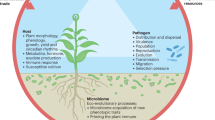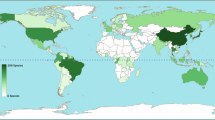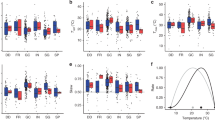Abstract
The past two decades have seen an increasing number of virulent infectious diseases in natural populations and managed landscapes. In both animals and plants, an unprecedented number of fungal and fungal-like diseases have recently caused some of the most severe die-offs and extinctions ever witnessed in wild species, and are jeopardizing food security. Human activity is intensifying fungal disease dispersal by modifying natural environments and thus creating new opportunities for evolution. We argue that nascent fungal infections will cause increasing attrition of biodiversity, with wider implications for human and ecosystem health, unless steps are taken to tighten biosecurity worldwide.
This is a preview of subscription content, access via your institution
Access options
Subscribe to this journal
Receive 51 print issues and online access
$199.00 per year
only $3.90 per issue
Buy this article
- Purchase on SpringerLink
- Instant access to full article PDF
Prices may be subject to local taxes which are calculated during checkout


Similar content being viewed by others
References
The Institute of Medicine. Fungal Diseases: an Emerging Threat to Human Animal and Wildlife Health (National Academy of Sciences, 2011)The output of a key workshop assessing the risk of novel fungal diseases.
Pennisi, E. Armed and dangerous. Science 327, 804–805 (2010)
Grünwald, N. J., Goss, E. M. & Press, C. M. Phytophthora ramorum: a pathogen with a remarkably wide host range causing sudden oak death on oaks and ramorum blight on woody ornamentals. Mol. Plant Pathol. 9, 729–740 (2008)
Anderson, P. K. et al. Emerging infectious diseases of plants: pathogen pollution, climate change and agrotechnology drivers. Trends Ecol. Evol. 19, 535–544 (2004)The first meta-analysis of emerging plant diseases. Reasons for this emergence are proposed and the cost to human welfare and biodiversity is estimated.
Brown, J. K. M. & Hovmoller, M. S. Aerial dispersal of pathogens on the global and continental scales and its impact on plant disease. Science 297, 537–541 (2002)
Daszak, P., Cunningham, A. A. & Hyatt, A. D. Emerging infectious diseases of wildlife—threats to biodiversity and human health. Science 287, 443–449 (2000)
Smith, K. F., Sax, D. F. & Lafferty, K. D. Evidence for the role of infectious disease in species extinction and endangerment. Conserv. Biol. 20, 1349–1357 (2006)
Blehert, D. S. et al. Bat white-nose syndrome: an emerging fungal pathogen? Science 323, 227 (2009)
Gargas, A., Trest, M. T., Christensen, M., Volk, T. J. & Blehert, D. S. Geomyces destructans sp. nov. associated with bat white-nose syndrome. Mycotaxon 108, 147–154 (2009)
Lorch, J. M. et al. Experimental infection of bats with Geomyces destructans causes white-nose syndrome. Nature 480, 376–378 (2011)
Frick, W. F. et al. An emerging disease causes regional population collapse of a common North American bat species. Science 329, 679–682 (2010)Population viability analysis showing the high risk of extinction of little brown bats caused by the emergence of a pathogenic fungus.
Boyles, J. G., Cryan, P. M., McCracken, G. F. & Kunz, T. H. Economic importance of bats in agriculture. Science 332, 41–42 (2011)
Berger, L. et al. Chytridiomycosis causes amphibian mortality associated with population declines in the rain forests of Australia and Central America. Proc. Natl Acad. Sci. USA 95, 9031–9036 (1998)The first study describing the discovery of amphibian chytridiomycosis in the tropics.
Longcore, J. E., Pessier, A. P. & Nichols, D. K. Batrachochytrium dendrobatidis gen. et sp. Nov., a chytrid pathogenic to amphibians. Mycologia 91, 219–227 (1999)
Fisher, M. C., Garner, T. W. J. & Walker, S. F. Global emergence of Batrachochytrium dendrobatidis and amphibian chytridiomycosis in space, time, and host. Annu. Rev. Microbiol. 63, 291–310 (2009)
Bd-Maps 〈http://www.bd-maps.net/〉 (accessed, February 2012)
Cheng, T. L., Rovito, S. M., Wake, D. B. & Vredenburg, V. T. Coincident mass extirpation of neotropical amphibians with the emergence of the infectious fungal pathogen Batrachochytrium dendrobatidis. Proc. Natl Acad. Sci. USA 108, 9502–9507 (2011)
Crawford, A. J., Lips, K. R. & Bermingham, E. Epidemic disease decimates amphibian abundance, species diversity, and evolutionary history in the highlands of central Panama. Proc. Natl Acad. Sci. USA 107, 13777–13782 (2010)
Colón-Gaud, C. et al. Assessing ecological responses to catastrophic amphibian declines: patterns of macroinvertebrate production and food web structure in upland Panamanian streams. Limnol. Oceanogr. 54, 331–343 (2009)
Stuart, S. N. et al. Status and trends of amphibian declines and extinctions worldwide. Science 306, 1783–1786 (2004)Analysis describing the high levels of amphibian extinctions caused by many environmental factors and disease.
Kim, K. & Harvell, C. D. The rise and fall of a six-year coral-fungal epizootic. Am. Nat. 164, S52–S63 (2004)
Cameron, S. A. et al. Patterns of widespread decline in North American bumble bees. Proc. Natl Acad. Sci. USA 108, 662–667 (2011)
Byrnes, E. J., III et al. Emergence and pathogenicity of highly virulent Cryptococcus gattii genotypes in the northwest United States. PLoS Pathog. 6, e1000850 (2010)
Simwami, S. P. et al. Low diversity Cryptococcus neoformans variety grubii multilocus sequence types from Thailand are consistent with an ancestral African origin. PLoS Pathog. 7, e1001343 (2011)
Holdich, D. M., Reynolds, J. D., Souty-Grosset, C. & Sibley, P. J. A review of the ever increasing threat to European crayfish from non-indigenous crayfish species. Knowl. Managt. Aquat. Ecosyst. 394–395, 11 (2009)
Andrew, T. G., Huchzermeyer, K. D. A., Mbeha, B. C. & Nengu, S. M. Epizootic ulcerative syndrome affecting fish in the Zambezi river system in southern Africa. Vet. Rec. 163, 629–631 (2008)
Rizzo, D. M. & Garbelotto, M. Sudden oak death: endangering California and Oregon forest ecosystems. Front. Ecol. Environ. 1, 197–204 (2003)
Wills, R. T. The ecological impact of Phytophthora cinnamomi in the Stirling Range National Park, Western Australia. Aust. J. Ecol. 18, 145–159 (1993)
Jaenike, J. An hypothesis to account for the maintenance of sex within populations. Evol. Theor. 3, 191–194 (1978)
Paterson, S. et al. Antagonistic coevolution accelerates molecular evolution. Nature 464, 275–278 (2010)
McCallum, H. & Dobson, A. Detecting disease and parasite threats to endangered species and ecosystems. Trends Ecol. Evol. 10, 190–194 (1995)
De Castro, F. & Bolker, B. Mechanisms of disease-induced extinction. Ecol. Lett. 8, 117–126 (2005)Theoretical study outlining the conditions under which disease can cause extinction of its host species.
Altizer, S., Nunn, C. L. & Lindenfors, P. Do threatened hosts have fewer parasites? A comparative study in primates. J. Anim. Ecol. 76, 304–314 (2007)
Daszak, P., Cunningham, A. A. & Hyatt, A. D. Emerging infectious diseases of wildlife—threats to biodiversity and human health. Science 287, 443–449 (2000)
Jones, K. E. et al. Global trends in emerging infectious diseases. Nature 451, 990–993 (2008)Macroecological analysis of recent patterns of EIDs worldwide in humans.
Casadevall, A. & Pirofski, L. A. The damage response framework of microbial pathogenesis. Nature Rev. Microbiol. 1, 17–24 (2003)
de Roode, J. C. et al. Virulence and competitive ability in genetically diverse malaria infections. Proc. Natl Acad. Sci. USA 102, 7624–7628 (2005)
Nowak, M. A. & May, R. M. Superinfection and the evolution of parasite virulence. Proc. R. Soc. Lond. B 255, 81–89 (1994)
Briggs, C. J., Knapp, R. A. & Vredenburg, V. T. Enzootic and epizootic dynamics of the chytrid fungal pathogen of amphibians. Proc. Natl Acad. Sci. USA 107, 9695–9700 (2010)
Stephens, P. A., Sutherland, W. J. & Freckleton, R. P. What is the Allee effect? Oikos 87, 185–190 (1999)
Mitchell, K. M., Churcher, T. S., Garner, T. W. G. & Fisher, M. C. Persistence of the emerging pathogen Batrachochytrium dendrobatidis outside the amphibian host greatly increases the probability of host extinction. Proc. R. Soc. B 275, 329–334 (2008)
Rypien, K. L., Andras, J. P. & Harvell, C. D. Globally panmictic population structure in the opportunistic fungal pathogen Aspergillus sydowii. Mol. Ecol. 17, 4068–4078 (2008)
Jessup, D. A. e. t. a. l. Southern sea otter as a sentinel of marine ecosystem health. EcoHealth 1, 239–245 (2004)
Sarmiento-Ramírez, J. M. et al. Fusarium solani is responsible for mass mortalities in nests of loggerhead sea turtle, Caretta caretta, in Boavista, Cape Verde. FEMS Microbiol. Lett. 312, 192–200 (2010)
Lindner, D. L. et al. DNA-based detection of the fungal pathogen Geomyces destructans in soils from bat hibernacula. Mycologia 103, 241–246 (2011)
Holt, R. D., Dobson, A. P., Begon, M., Bowers, R. G. & Schauber, E. M. Parasite establishment in host communities. Ecol. Lett. 6, 837–842 (2003)
Hansen, E. M., Parke, J. L. & Sutton, W. Susceptibility of Oregon forest trees and shrubs to Phytophthora ramorum: a comparison of artificial inoculation and natural infection. Plant Dis. 89, 63–70 (2005)
Fröhlich-Nowoisky, J., Pickersgill, D. A., Despres, V. R. & Poschl, U. High diversity of fungi in air particulate matter. Proc. Natl Acad. Sci. USA 106, 12814–12819 (2009)
Henk, D. A. et al. Speciation despite globally overlapping distributions in Penicillium chrysogenum: the population genetics of Alexander Fleming's lucky fungus. Mol. Ecol. 20, 4288–4301 (2011)
Pringle, A., Baker, D. M., Platt, J. L., Latge, J. P. & Taylor, J. W. Cryptic speciation in the cosmopolitan and clonal human pathogenic fungus Aspergillus fumigatus. Evolution 59, 1886–1899 (2005)
Ellison, C. E. et al. Population genomics and local adaptation in wild isolates of a model microbial eukaryote. Proc. Natl Acad. Sci. USA 108, 2831–2836 (2011)
Giraud, T., Gladieux, P. & Gavrilets, S. Linking the emergence of fungal plant diseases with ecological speciation. Trends Ecol. Evol. 25, 387–395 (2010)
Springer, D. J. & Chaturvedi, V. Projecting global occurrence of Cryptococcus gattii. Emerg. Infect. Dis. 16, 14–20 (2010)
Seimon, T. A. et al. Upward range extension of Andean anurans and chytridiomycosis to extreme elevations in response to tropical deglaciation. Glob. Change Biol. 13, 288–299 (2007)
Fisher, M. C. et al. Biogeographic range expansion into South America by Coccidioides immitis mirrors New World patterns of human migration. Proc. Natl Acad. Sci. USA 98, 4558–4562 (2001)
Stukenbrock, E. H. & McDonald, B. A. The origins of plant pathogens in agro-ecosystems. Annu. Rev. Phytopathol. 46, 75–100 (2008)
Brasier, C. M. The biosecurity threat to the UK and global environment from international trade in plants. Plant Pathol. 57, 792–808 (2008)An analysis of the lack of biosecurity and of the risk of disease introduction associated with the international plant trade.
Milgroom, M. G., Wang, K. R., Zhou, Y., Lipari, S. E. & Kaneko, S. Intercontinental population structure of the chestnut blight fungus, Cryphonectria parasitica. Mycologia 88, 179–190 (1996)
Gonthier, P., Warner, R., Nicolotti, G., Mazzaglia, A. & Garbelotto, M. M. Pathogen introduction, as a collateral effect of military activity. Mycol. Res. 108, 468–470 (2004)
Goka, K. et al. Amphibian chytridiomycosis in Japan: distribution, haplotypes and possible route of entry into Japan. Mol. Ecol. 18, 4757–4774 (2009)
Garner, T. W. J. et al. The emerging amphibian pathogen Batrachochytrium dendrobatidis globally infects introduced populations of the North American bullfrog, Rana catesbeiana. Biol. Lett. 2, 455–459 (2006)
Cunningham, A. A. et al. Emergence of amphibian chytridiomycosis in Britain. Vet. Rec. 157, 386–387 (2005)
Walker, S. F. et al. Invasive pathogens threaten species recovery programs. Curr. Biol. 18, R853–R854 (2008)
Farrer, R. A. et al. Multiple emergences of genetically diverse amphibian-infecting chytrids include a globalised hypervirulent recombinant lineage. Proc. Natl Acad. Sci. USA 108, 18732–18736 (2011)Population genomics analysis of the generation, and spread, of a hypervirulent fungal lineage in amphibians worldwide.
Wibbelt, G. et al. White-nose syndrome Fungus (Geomyces destructans) in Bats, Europe. Emerg. Infect. Dis. 16, 1237–1243 (2010)
Richards, T. A. et al. Horizontal gene transfer facilitated the evolution of plant parasitic mechanisms in the oomycetes. Proc. Natl Acad. Sci. USA 108, 15258–15263 (2011)
Fraser, J. A. et al. Same-sex mating and the origin of the Vancouver Island Cryptococcus gattii outbreak. Nature 437, 1360–1364 (2005)Analysis of the evolution of a hypervirulent lineage of human-infecting fungus that invaded British Columbia.
Turner, E., Jacobson, D. J. & Taylor, J. W. Genetic architecture of a reinforced, postmating, reproductive isolation barrier between Neurospora species indicates evolution via natural selection. PLoS Genet. 7, e1002204 (2011)
Coyne, J. A. & Orr, H. A. Speciation (Sinauer Associates, 2004)
Mallet, J. Hybrid speciation. Nature 446, 279–283 (2007)
Brasier, C. M., Rose, J. & Gibbs, J. N. An unusual phytophthora associated with widespread alder mortality in Britain. Plant Pathol. 44, 999–1007 (1995)
Inderbitzin, P., Davis, R. M., Bostock, R. M. & Subbarao, K. V. The ascomycete Verticillium longisporum is a hybrid and a plant pathogen with an expanded host range. PLoS One 6, e18260 (2011)
Gange, A. C., Gange, E. G., Sparks, T. H. & Boddy, L. Rapid and recent changes in fungal fruiting patterns. Science 316, 71 (2007)
Pachauri, R. K., Resinger, A., eds. Climate change 2007: Synthesis report. (Intergovernmental Panel on Climate Change, 2007)
Newton, A. C., Johnson, S. N. & Gregory, P. J. Implications of climate change for diseases, crop yields and food security. Euphytica 179, 3–18 (2011)This paper highlights the importance of understanding the impact of climate change on crops and disease.
Lake, J. A. & Wade, R. N. Plant–pathogen interactions and elevated CO2: morphological changes in favour of pathogens. J. Exp. Bot. 60, 3123–3131 (2009)
Chakraborty, S. et al. Impacts of global change on diseases of agricultural crops and forest trees. CAB Rev. 3, 1–5 (2008)
Kobayashi, T. et al. Effects of elevated atmospheric CO2 concentration on the infection of rice blast and sheath blight. Phytopathology 96, 425–431 (2006)
Madgwick, J. W. et al. Impacts of climate change on wheat anthesis and fusarium ear blight in the UK. Eur. J. Plant Pathol. 130, 117–131 (2011)
Gregory, P. J., Johnson, S. N., Newton, A. C. & Ingram, J. S. I. Integrating pests and pathogens into the climate change/food security debate. J. Exp. Bot. 60, 2827–2838 (2009)
Pounds, J. A. et al. Widespread amphibian extinctions from epidemic disease driven by global warming. Nature 439, 161–167 (2006)
Bosch, J., Carrascal, L. M., Duran, L., Walker, S. & Fisher, M. C. Climate change and outbreaks of amphibian chytridiomycosis in a montane area of Central Spain; is there a link? Proc. R. Soc. B 274, 253–260 (2007)
Rohr, J. R., Raffel, T. R., Romansic, J. M., McCallum, H. & Hudson, P. J. Evaluating the links between climate, disease spread, and amphibian declines. Proc. Natl Acad. Sci. USA 105, 17436–17441 (2008)
Garner, T. W. J., Rowcliffe, J. M. & Fisher, M. C. Climate change, chytridiomycosis or condition: an experimental test of amphibian survival. Glob. Change Biol. 17, 667–675 (2011)
Becker, C. G. & Zamudio, K. R. Tropical amphibian populations experience higher disease risk in natural habitats. Proc. Natl Acad. Sci. USA 108, 9893–9898 (2011)
Harvell, C. D. et al. Review: Emerging marine diseases - Climate links and anthropogenic factors. Science 285, 1505–1510 (1999)
vanEngelsdorp, D. et al. Colony collapse disorder: a descriptive study. PLoS One 4, e6481 (2009)
Ratnieks, F. L. W. & Carreck, N. L. Clarity on honey bee collapse? Science 327, 152–153 (2010)
Verweij, P. E., Mellado, E. & Melchers, W. J. G. Multiple-triazole-resistant aspergillosis. N. Engl. J. Med. 356, 1481–1483 (2007)
Klaassen, C. H. W., Gibbons, J. G., Fedorova, N. D., Meis, J. F. & Rokas, A. Evidence for genetic differentiation and variable recombination rates among Dutch populations of the opportunistic human pathogen Aspergillus fumigatus. Mol. Ecol. 21, 57–70 (2012)
Miraglia, M. et al. Climate change and food safety: an emerging issue with special focus on Europe. Food Chem. Toxicol. 47, 1009–1021 (2009)
Stokstad, E. The famine fighter’s last battle. Science 324, 710–712 (2009)
Loo, J. A. Ecological impacts of non-indigenous invasive fungi as forest pathogens. Biol. Invasions 11, 81–96 (2009)
Kurz, W. A. et al. Mountain pine beetle and forest carbon feedback to climate change. Nature 452, 987–990 (2008)Study describing pest- and pathogen-induced loss of forest carbon sinks.
Mazzoni, R. et al. Emerging pathogen of wild amphibians in frogs (Rana catesbeiana) farmed for international trade. Emerg. Infect. Dis. 9, 995–998 (2003)
Byrnes, E. J., III, Bildfell, R. J., Dearing, P. L., Valentine, B. A. & Heitman, J. Cryptococcus gattii with bimorphic colony types in a dog in western Oregon: additional evidence for expansion of the Vancouver Island outbreak. J. Vet. Diagn. Invest. 21, 133–136 (2009)
Lubick, N. Emergency medicine for frogs. Nature 465, 680–681 (2010)
Harris, R. N. et al. Skin microbes on frogs prevent morbidity and mortality caused by a lethal skin fungus. ISME J. 3, 818–824 (2009)
U.S. Fish and Wildlife Service A national plan for assisting states, federal agencies, and tribes in managing white-nose syndrome in bats. 〈http://www.fws.gov/WhiteNoseSyndrome/pdf/WNSnationalplanMay2011.pdf〉 (2011)
Acknowledgements
M.C.F. was supported by grants from the Wellcome Trust, Natural Environment Research Council (NERC), and the European Research Area (ERA)-net project BiodivERsA. D.A.H. was supported by a grant from the Leverhulme Trust, C.J.B. was supported by the US National Science Foundation (NSF) Ecology of Infectious Disease grant EF-0723563. S.J.G. was supported by grants from the UK Biotechnology and Biological Sciences Research Council (BBSRC) and the John Fell Fund of the University of Oxford, and S.L.M. was supported by a graduate scholarship from Magdalen College, University of Oxford. J.S.B. was supported by Google.org and the National Institutes of Health grant 5R01LM010812-02. N. Knowlton and J. Heitman provided impetus to develop this review.
Author information
Authors and Affiliations
Contributions
M.C. F., D.A.H., C.J.B., S.L.M. and S.J.G designed, analysed and wrote the paper. Data were collected and analysed by J.S.B. and L.C.M.
Corresponding authors
Ethics declarations
Competing interests
The authors declare no competing financial interests.
Supplementary information
Supplementary Information
This file contains Supplementary Tables 1-5 and additional references. (PDF 343 kb)
PowerPoint slides
Rights and permissions
About this article
Cite this article
Fisher, M., Henk, D., Briggs, C. et al. Emerging fungal threats to animal, plant and ecosystem health. Nature 484, 186–194 (2012). https://doi.org/10.1038/nature10947
Received:
Accepted:
Published:
Issue Date:
DOI: https://doi.org/10.1038/nature10947
This article is cited by
-
MycoNews 2023: Editorial, news, reports, awards, personalia, and book news
IMA Fungus (2024)
-
eDNA-based monitoring of Batrachochytrium dendrobatidis and Batrachochytrium salamandrivorans with ddPCR in Luxembourg ponds: taking signals below the Limit of Detection (LOD) into account
BMC Ecology and Evolution (2024)
-
Effects of ophidiomycosis on movement, survival, and reproduction of eastern foxsnakes (Pantherophis vulpinus)
Scientific Reports (2024)
-
Impact of socioeconomic factors on soil-borne animal pathogenic fungi in urban greenspaces
Nature Cities (2024)
-
Plastiphily is linked to generic virulence traits of important human pathogenic fungi
Communications Earth & Environment (2024)



